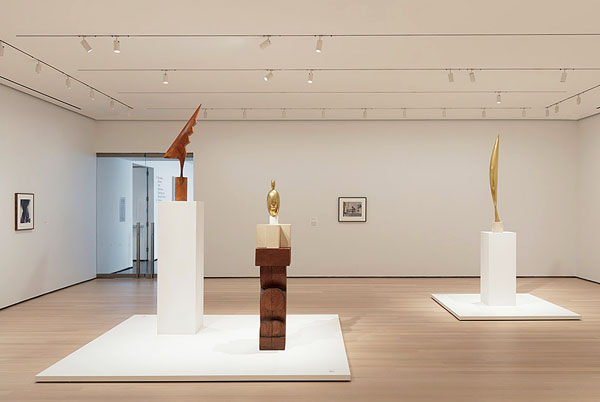Constantin Brancusi Sculpture Exhibition Debuts at MoMA
Sculptor Constantin Brancusi’s achievements and innovations are showcased beautifully in a new exhibition unveiled at The Museum of Modern Art (MoMA) recently. On view through February 18, 2019, Constantin Brancusi Sculpture presents a concentrated survey of MoMA’s exclusive holdings of Brancusi’s work, demonstrating the artist’s singular approach to materials, among them bronze, stone, and wood.
 Installation view of Constantin Brancusi Sculpture, The Museum of Modern Art,
Installation view of Constantin Brancusi Sculpture, The Museum of Modern Art, New York, July 22, 2018–February 18, 2019. © 2018 The Museum of Modern Art.
Photo by Denis Doorly.
In this rare exhibition, 11 sculptures by the artist are being shown together for the first time, alongside drawings, photographs, and films to demonstrate extensions of his sculptural endeavors.
Also on view is a selection of archival materials that sheds light on the artist’s working process and his relationships with friends, sitters, and patrons, including this Museum. Constantin Brancusi Sculpture is organized by Paulina Pobocha, Associate Curator, with Mia Matthias, Curatorial Fellow, Department of Painting and Sculpture.
Although Brancusi made hundreds of sculptures in his lifetime, he limited his subject matter to people and animals, with just a handful of exceptions. He especially preferred portraits of women, as seen in Mlle. Pogany and Blond Negress, II; children’s heads; and birds, exemplified by Maiastra and Bird in Space. In his work, he pushed sculpture to the threshold of abstraction. Equally revolutionary was Brancusi’s approach to his sculptures’ pedestals. Brancusi filled his studio space with functional objects he made himself, such as stools, fireplaces, benches, as well as pedestals for his sculptures. These pedestals, made from wood, limestone, and marble, became part of the artwork; many were created for specific sculptures, and some were constructed from existing sculptures. For example, he incorporated the sculpture Double Caryatid, which depicts two figures, into the base of Maiastra. On other occasions, Brancusi made pedestals that could support a variety of sculptures rather than one work in particular. His bases thus performed a dual function, serving simultaneously as components of the artwork and as their support.
Brancusi’s bases also position the sculpture at a height that references their subject matter. For example, his Bird in Space works soar high above one’s head, often set on lofty tripartite bases. His portraits are typically positioned at eye level, and the heads of children and sleeping women tend to live low to the ground. The unprecedented importance Brancusi bestowed on his bases transformed sculpture’s relationship to the space it inhabits and, by extension, to the world at large: If a base is part of the art, what differentiates art from its surroundings?
Brancusi’s least-known experiments, however, unfold in film. With his friend Man Ray, who introduced him to the medium, Brancusi made films that captured him working with his materials, activating his artworks through movement, and revealing his sources of inspiration, such as animals, light in nature, and dance. Although few of Brancusi’s films survive, many of those that do demonstrate his interest in the movement of objects through space and affirm his desire for his work to be experienced in the round.
Resources:
Also in this Issue:
- Free Spirited Copper Creations
- Buddy Knight, A Metal Artist in the True Western Tradition
- Rare Multi-Million Dollar Misprint Penny Displayed at Philadelphia World's Fair of Money
- Rare Remington Sculptures Gifted to Newark Museum
- Constantin Brancusi Sculpture Exhibition Debuts at MoMA
